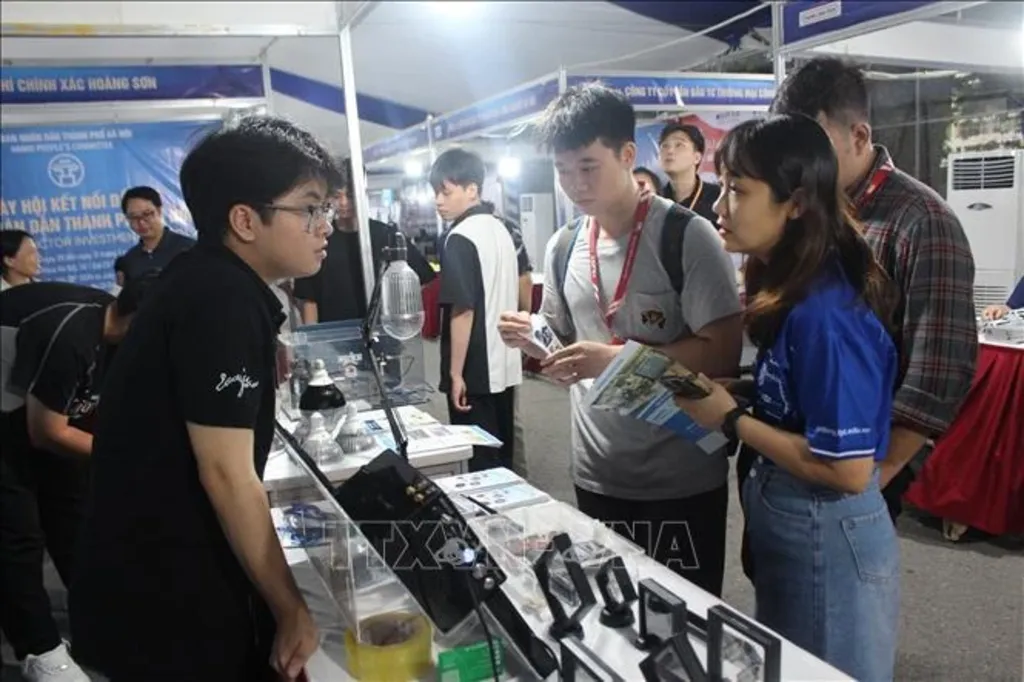 |
| Representatives from enterprises at the Hanoi Semiconductor Investment Festival 2024__Photo: VNA |
As Vietnam’s chip-semiconductor industry sees bright opportunities to thrive, human resources training is identified as a top priority.
According to the Ministry of Information and Communications (MIC), the workforce demand for information technology (IT) and digital industry in Vietnam is estimated at 150,000 engineers per year.
The country’s actual labor force can only respond to about 40-50 percent of this figure, while for the semiconductor industry, only around 20 percent of its labor demand can be met.
Vu Quang Hung, Deputy Director of the Vietnam Institute of Strategy and Policy for Industry and Trade (VIOIT), said that while Vietnam has long been a part of the semiconductor supply chain, its engagement remains only at the packing and testing stages for several major chip manufacturers, like Intel.
He added that semiconductors are available in a wide variety, but Vietnam’s packaging capacity has only been able to respond to simpler types.
Do Thi Thuy Huong, an Executive Board Member of the Vietnam Electronics Industries Association - a non-governmental organization representing more than 300 electronic industry enterprises in Vietnam, said that the semiconductor industry involves many areas, from investment and production to technology development and updates.
The industry needs qualified integrated circuit (IC) design engineers and a workforce that can master the semiconductor manufacturing processes, she added.
FPT Deputy General Director Hoang Viet Anh said that Vietnam now has only about 5,000 engineers working in 40 chip and semiconductor companies in the country, and the country has a roadmap to increase the number of engineers 10 times from now until 2030.
Major Vietnamese IT companies including Viettel, Vietnam Posts and Telecommunications Group (VNPT) and FPT are proactively taking action to increase their capacity in research, development, and production in this sector.
FPT provides outsourcing services to chip producers from the US, Japan, and the Republic of Korea (RoK), and is developing human resources in the chip-semiconductor industry.
Specifically, in addition to establishing the FPT Semiconductor Joint Stock Company in 2022, the group has also been training engineers specializing in chips and semiconductors.
It targets to provide about 10,000 engineers by 2030.Experts believe that Vietnam has a great opportunity to grow its semiconductor industry with the involvement of multiple leading global technology companies.
It is forecast that by the end of 2024, Vietnam’s semiconductor industry will exceed USD 6.16 billion in value, becoming one of the key manufacturing hubs of many global enterprises.
Samsung from the RoK has chosen Vietnam as its largest product development center in Southeast Asia.
Several Dutch semiconductor companies have begun directing their investments to their Vietnamese facilities.BE Semiconductor Industries N.V. from the Netherlands has obtained an investment certificate at Saigon Hi-tech Park with a capital of more than VND 115 billion (USD 4.9 million) in the first phase.
The company’s project is expected to enter operation in the first quarter of next year.
Semiconductor provider Amkor Technology from the RoK in July increased the capital in its factory in Yen Phong II-C Industrial Park in the northern province of Bac Ninh by over USD 1.07 billion.
In June, the province also issued an investment registration certificate to Foxconn Circuit Precision (Vietnam) Co. Ltd. for its USD 383.33-million factory in Nam Son-Hap Linh Industrial Park.
During her first visit to Vietnam in July, US Secretary of the Treasury Janet Yellen said that Vietnam has emerged as a critical node in the global semiconductor supply chain.
Vietnam and the US have also worked together to bolster resilient supply chains, especially regarding the semiconductor industry, she added.- (VNA/VLLF)









